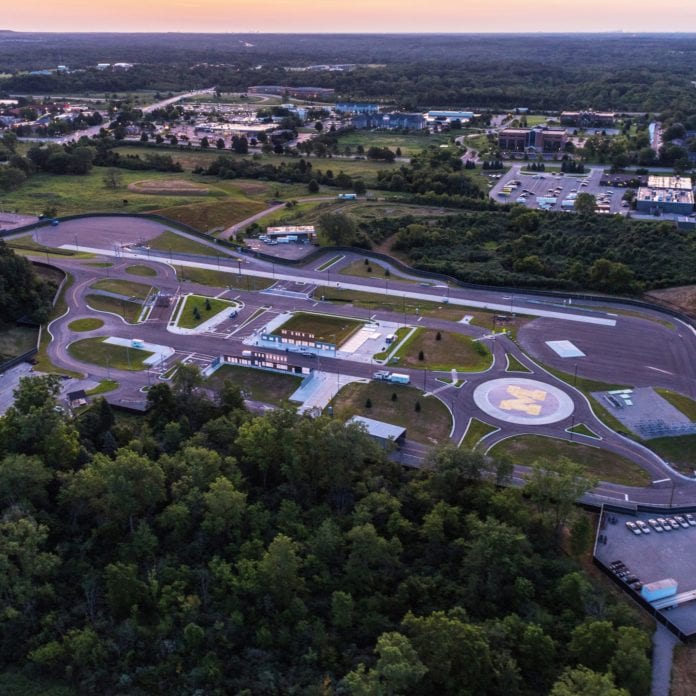The University of Michigan has opened its new M-City connected car testbed, partnering with automotive and technology companies including Ford, Honda, Toyota, Nissan, General Motors, Qualcomm Technologies and Verizon Communications, for research and development on driverless vehicles.
The 32-acre site re-creates urban and suburban road environments complete with building façades, sidewalks, streetlights and stoplights. It is designed to be a challenging environment, with graffiti-covered road signs, faded lane paint, different road surfaces and even construction areas. M-City was designed by U-M’s Mobility Transformation Center in partnership with the Michigan Department of Transportation. For more pictures, a diagram of the test facility and videos about the site, look here. Verizon talks about its perspective on the project here.
The testing at M-City will cover vehicle-to-vehicle and vehicle-to-infrastructure communications, as well as a range of automation features, up to and including fully autonomous vehicles.
Including the seven mentioned above, 15 companies have committed to investing $1 million each in the MTC over the next three years. Another 33 companies are participating and investing $150,000 each. The university and MDOT have already invested $10 million in the test facility, and the MTC has the goal of having a “shared network of connected, automated (including driverless) vehicles on the road in Ann Arbor by 2021.”
The MTC already has three connected-vehicle deployments in progress for Ann Arbor and southeast Michigan.
“This unique combination of a purpose-built test environment and real-world deployments sets U-M apart from other organizations and institutions doing similar work,” said Jim Sayer, director for deployment at MTC, in a statement.
• Rohde & Schwarz continues to support the development of IP Media Subsystem-related testing, with news this week that it has validated the first conformance test case for Rich Communications Suite 5.1. Rohde said it “has repeatedly been the first and only provider to carry out validation for an IMS work item.”
The RCS conformance test validation happened as part of a recent Global Certification Forum’s Conformance and Interoperability Agreement Group meeting in Malaga, using a new software option for the R&S CMW500 wideband radio communication tester.
• Tektronix is outfitting a new research lab at the University of Lille in France, in partnership with the university’s Research Institute on Hardware-Software devices for Advanced Information and Communication.
The new Tektronix European Optical and Wireless Innovation Laboratory will support research on ultra-high-speed coherent optical and wireless technologies. The facility also will be available to companies that are developing new wireless and optical technologies.
In particular, research there will explore approaches for getting optical data transmission rates beyond a petabyte per second range, as well as terahertz, or sub-millimeter, wireless transceiver technology.
• Keysight Technologies is partnering with Japanese mobile operator NTT DoCoMo as the carrier aims for a 5G technology launch in 2020. Keysight announced this week that it will be “actively supporting” NTT’s 5G research and providing test solutions and expertise in areas including millimeter wave.
• Speaking of 5G, Tod Sizer II, who leads Alcatel-Lucent Bell Labs, spoke with me this week on his top 10 areas for 5G research. Read that article here.
• Japan-based Taiyo Pacific Partners said this week that after accumulating more than 5% of Anritsu’s stock, it is now the company’s fourth-largest institutional shareholder.
• Polystar’s Odin service enablement solution, an IMS application server, was recently chosen by Cirrus Core Networks of Boca Raton, Fla., to support the launch of a “fully virtualized,” managed voice-over-LTE service. CCN serves mobile network operators, mobile virtual network operators and machine-to-machine/”Internet of Things” providers.
• GL Communications has new RTP video traffic generation and analysis software for simulating and monitoring video traffic and understanding its impact on the network.

